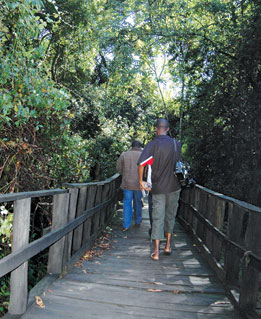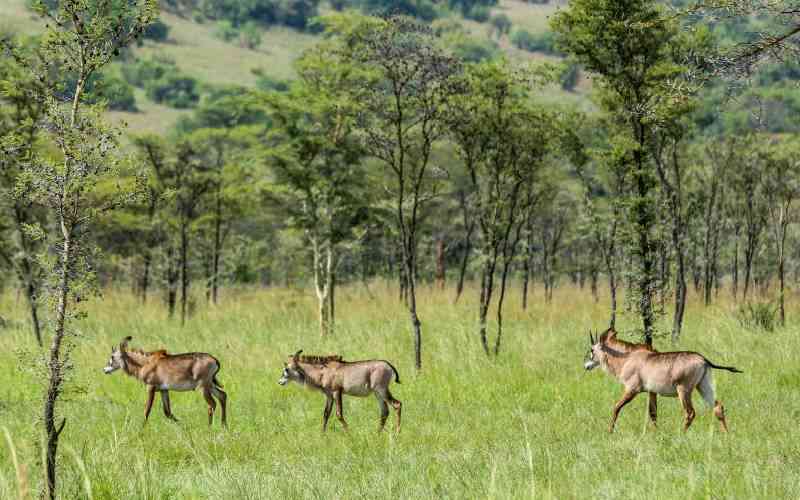Augustine Oduor got more than he bargained for when he took a trip up North to Trans Nzoia District in search of Kenya’s smallest park.
No! It is not in your travel itinerary this holiday. Chances that someone may call you up to accompany them there for a weekend travel are almost nil. This is because it is not one of the premier parks that we see marketed everyday.
It is a small protected three-kilometre square piece of park on the northern side of Kitale town called Saiwa Swamp National Park. This little piece of land filled with bushes and trees, also known as the smallest national park in the country, has for long been known as home to the rare ‘sitatunga’ antelope.
As the elders said long ago, "seeing is believing", I decided to venture and see for myself. The swamp is 15 kilometres from Kitale town and east of the Kitale-Kapenguria road. It is carefully nestled in the Rift Valley about 385km northwest of Nairobi and close to the Ugandan border.
There was every indication the park is not commonly visited by many people on an ordinary day, and as I entered the gate, a wee bit of scepticism engulfed me. I was not sure of the gem awaiting my vision, if at all there was a gem in the first place.
Our car screeched to a halt right at the door of the administration block at about 10am, prompt to a warm reception of the park staff. And as I stepped out of the van, my lips clenched to a smile at the black board rested under a beautiful tree with inscription:
"Tree planted by Kalembe Ndile, Wildlife Assistant Minister."
Marshy edge
 |
The writer on a section of the 15km walking trail at the park. [PHOTOS: COURTESY] |
The antelope, a good swimmer, hides underwater when it senses danger, with just the tip of the nose showing. And in a flush, it dipped into the water again after a colleague made a hissing sound of amazement that scared it off.
"If we were patient enough, we would have seen the entire body of the antelope that stands about five feet tall and has shaggy, waterproof coats," said the warden.
Sitatungas are swamp-dwelling antelopes found in Central and East Africa. In Kenya they are only found in Kengwal, Saiwa and a few at Yala swamp. They have long legs and elongated hooves that allow them to outrun danger in the swamps.
Females have a reddish-brown coat while the males are dark brown and have a mane and horns. Their remarkable twisted horns can reach up to three feet or more in length.
To those who have had a chance to visit the park, this is often the peak of the tour: watching the rare semi-aquatic antelope.
Stay informed. Subscribe to our newsletter
But having lost the golden opportunity to fully see the rare animal, we found consolation in the many bird species that hovered and chirped in systematic musical rhythm as they perched from one branch to another. We stood a top the tallest viewing tower, watched the birds and soaked the sun as we let the freshness of the air arrest our nostrils in one of the continents exotic campsites.
According to Manyende, there are up to 372 species of birds in the park, including the Ross turaco and the blue-headed coucal. It is advisable to wear a hat just in case the birds ‘do it’ on your well-made hair when visiting the park, our guide warned us.
Indulating topography
And if you would like to spend the night and share the adventure with family and friends as the day draws to an end and the stars come out to play, you need not worry.
The park has both special and ordinary campsites. The special option provides a campsite where you bring your tent and all else you may need during your visit. And if you need security, "it will be provided by animals," says Manyende.
And for the ordinary campsite, a tent and water is provided. The undulating topography provides space enough for a modest party or picnic. All visitors to the national park are advised to carry their food.
Accommodation is also readily available in the nearest Kitale town with several hotels offering bed and breakfast services.
As we drove out of the park, there was no doubt Saiwa Swamp National Park is a perfect example of how a small area can survive as a complete ecological entity.
I tell this story as can only be told by a friend.
 The Standard Group Plc is a
multi-media organization with investments in media platforms spanning newspaper
print operations, television, radio broadcasting, digital and online services. The
Standard Group is recognized as a leading multi-media house in Kenya with a key
influence in matters of national and international interest.
The Standard Group Plc is a
multi-media organization with investments in media platforms spanning newspaper
print operations, television, radio broadcasting, digital and online services. The
Standard Group is recognized as a leading multi-media house in Kenya with a key
influence in matters of national and international interest.
 The Standard Group Plc is a
multi-media organization with investments in media platforms spanning newspaper
print operations, television, radio broadcasting, digital and online services. The
Standard Group is recognized as a leading multi-media house in Kenya with a key
influence in matters of national and international interest.
The Standard Group Plc is a
multi-media organization with investments in media platforms spanning newspaper
print operations, television, radio broadcasting, digital and online services. The
Standard Group is recognized as a leading multi-media house in Kenya with a key
influence in matters of national and international interest.







